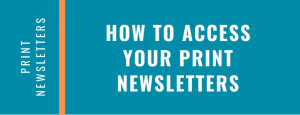Well, you know what I’m going to say – send both!
But seriously, let me explain the pros and cons of each.
Print newsletters
Pros:
- They are a physical object. There’s something about being able to hold something in your hand that makes the communication more powerful.
- They won’t get trapped in spam filters.
- They provide, in many cases, a better return on investment.
- You can send them even to people you don’t know.
Cons:
- Relatively expensive to print and email
- More time-consuming to edit and prepare
Email newsletters
Pros:
- They are cheap and easy to send.
- You can send large numbers.
- You can send them frequently.
Cons:
- Some will get trapped in spam filters.
- People’s inboxes are overflowing.
- You can send them only to people who have given you permission.
Here is what I suggest you do. This is, of course, just general advice. You must do what is right for your own business.
Collect as many email addresses as possible and send an email newsletter to each of your prospects and clients, at least once per month. Doing this is a no-brainer because you can send 1000 per month as part of your subscription with us, and even if you want to send more, it costs only $1.50 per 100 extra. Continue to collect email addresses to build your database.
However, just because email newsletters seem more modern and are cheaper, you should not ignore printed newsletters.
We advise you to collect as many mailing addresses as possible but be strategic as to who you send your print newsletters to. We find that best results come from sending to existing/past clients. In addition, you can get good results from sending newsletters to your recent leads and occasionally sending them to your list of older leads. It is, however, important to keep an eye on your return on investment – whether something makes sense for you depends on your response rate and your profit per item sold.
One thing to watch out for is sending out thousands of print newsletters to people who are not in your database. While this can work as a long-term strategy, the cost of doing a large mailing means that you have to have deep pockets. The danger is, you will run out of money before you are able to judge whether your strategy is working.
Newsletters are for people who think long-term. That’s why we give a big break on our prices to people who are willing to commit for a year. It’s no good sending out just a handful of newsletters for a couple of months and then giving up. You’ll never know if they would have worked or not!
So…while you’re thinking of whether to send print newsletters or email newsletters, consider how best to mix them up to get the biggest bang for your buck.
